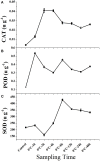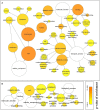Transcriptomic Response of Chinese Yew (Taxus chinensis) to Cold Stress
- PMID: 28503178
- PMCID: PMC5408010
- DOI: 10.3389/fpls.2017.00468
Transcriptomic Response of Chinese Yew (Taxus chinensis) to Cold Stress
Abstract
Taxus chinensis is a rare and endangered shrub, highly sensitive to temperature changes and widely known for its potential in cancer treatment. How gene expression of T. chinensis responds to low temperature is still unknown. To investigate cold response of the genus Taxus, we obtained the transcriptome profiles of T. chinensis grown under normal and low temperature (cold stress, 0°C) conditions using Illumina Miseq sequencing. A transcriptome including 83,963 transcripts and 62,654 genes were assembled from 4.16 Gb of reads data. Comparative transcriptomic analysis identified 2,025 differently expressed (DE) isoforms at p < 0.05, of which 1,437 were up-regulated by cold stress and 588 were down-regulated. Annotation of DE isoforms indicated that transcription factors (TFs) in the MAPK signaling pathway and TF families of NAC, WRKY, bZIP, MYB, and ERF were transcriptionally activated. This might have been caused by the accumulation of secondary messengers, such as reactive oxygen species (ROS) and Ca2+. While accumulation of ROS will have caused damages to cells, our results indicated that to adapt to low temperatures T. chinensis employed a series of mechanisms to minimize these damages. The mechanisms included: (i) cold-enhanced expression of ROS deoxidant systems, such as peroxidase and phospholipid hydroperoxide glutathione peroxidase, to remove ROS. This was further confirmed by analyses showing increased activity of POD, SOD, and CAT under cold stress. (ii) Activation of starch and sucrose metabolism, thiamine metabolism, and purine metabolism by cold-stress to produce metabolites which either protect cell organelles or lower the ROS content in cells. These processes are regulated by ROS signaling, as the "feedback" toward ROS accumulation.
Keywords: DE isoforms; ROS; Taxus chinensis; cold response; cold stress; transcriptome.
Figures





Similar articles
-
Response of rhizosphere bacterial community of Taxus chinensis var. mairei to temperature changes.PLoS One. 2019 Dec 12;14(12):e0226500. doi: 10.1371/journal.pone.0226500. eCollection 2019. PLoS One. 2019. PMID: 31830112 Free PMC article.
-
Genes, pathways and transcription factors involved in seedling stage chilling stress tolerance in indica rice through RNA-Seq analysis.BMC Plant Biol. 2019 Aug 14;19(1):352. doi: 10.1186/s12870-019-1922-8. BMC Plant Biol. 2019. PMID: 31412781 Free PMC article.
-
A De Novo Transcriptome Analysis Identifies Cold-Responsive Genes in the Seeds of Taxillus chinensis (DC.) Danser.Biomed Res Int. 2022 Jul 6;2022:9247169. doi: 10.1155/2022/9247169. eCollection 2022. Biomed Res Int. 2022. PMID: 35845948 Free PMC article.
-
Transcriptome analysis provides insights into light condition effect on paclitaxel biosynthesis in yew saplings.BMC Plant Biol. 2022 Dec 12;22(1):577. doi: 10.1186/s12870-022-03958-2. BMC Plant Biol. 2022. PMID: 36503377 Free PMC article.
-
Global Transcriptome Profiles of 'Meyer' Zoysiagrass in Response to Cold Stress.PLoS One. 2015 Jun 26;10(6):e0131153. doi: 10.1371/journal.pone.0131153. eCollection 2015. PLoS One. 2015. PMID: 26115186 Free PMC article.
Cited by
-
De novo transcriptome assembly and comparative transcriptomic analysis provide molecular insights into low temperature stress response of Canarium album.Sci Rep. 2021 May 18;11(1):10561. doi: 10.1038/s41598-021-90011-1. Sci Rep. 2021. PMID: 34006894 Free PMC article.
-
Response of rhizosphere bacterial community of Taxus chinensis var. mairei to temperature changes.PLoS One. 2019 Dec 12;14(12):e0226500. doi: 10.1371/journal.pone.0226500. eCollection 2019. PLoS One. 2019. PMID: 31830112 Free PMC article.
-
Multi-Omics Analysis Provides Insights into Green Soybean in Response to Cold Stress.Metabolites. 2024 Dec 7;14(12):687. doi: 10.3390/metabo14120687. Metabolites. 2024. PMID: 39728468 Free PMC article.
-
Effect of Rhizobium Symbiosis on Low-Temperature Tolerance and Antioxidant Response in Alfalfa (Medicago sativa L.).Front Plant Sci. 2019 Apr 30;10:538. doi: 10.3389/fpls.2019.00538. eCollection 2019. Front Plant Sci. 2019. PMID: 31114600 Free PMC article.
-
Full-Length Transcriptome Analysis of Four Different Tissues of Cephalotaxus oliveri.Int J Mol Sci. 2021 Jan 14;22(2):787. doi: 10.3390/ijms22020787. Int J Mol Sci. 2021. PMID: 33466772 Free PMC article.
References
LinkOut - more resources
Full Text Sources
Other Literature Sources
Miscellaneous

